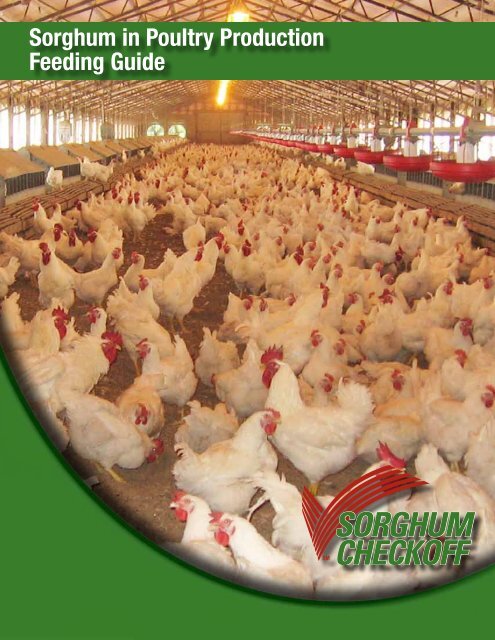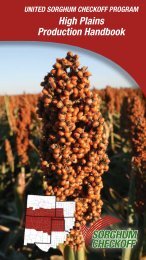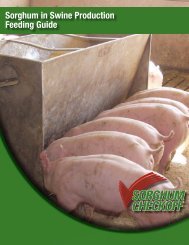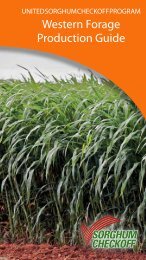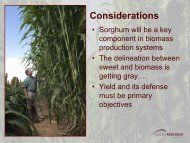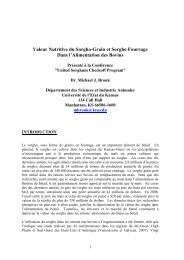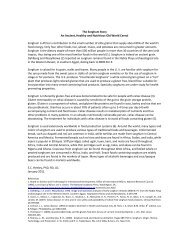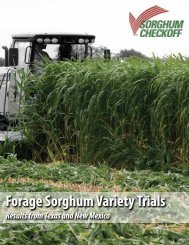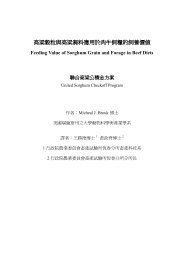Sorghum in Poultry Production Feeding Guide - Sorghum Checkoff
Sorghum in Poultry Production Feeding Guide - Sorghum Checkoff
Sorghum in Poultry Production Feeding Guide - Sorghum Checkoff
You also want an ePaper? Increase the reach of your titles
YUMPU automatically turns print PDFs into web optimized ePapers that Google loves.
<strong>Sorghum</strong> <strong>in</strong> <strong>Poultry</strong> <strong>Production</strong><br />
Feed<strong>in</strong>g <strong>Guide</strong>
When determ<strong>in</strong><strong>in</strong>g the value of your<br />
feedstuffs it is important to remember:<br />
• <strong>Sorghum</strong> DDGs are naturally darker <strong>in</strong> color and have excellent<br />
nutritional value.<br />
• Color only matters when you don’t know the nutritional<br />
value of your dry distillers gra<strong>in</strong> product.<br />
• Ask your distillers marketer for your dry distillers gra<strong>in</strong><br />
nutritional facts.<br />
<strong>Sorghum</strong> <strong>in</strong> <strong>Poultry</strong> <strong>Production</strong> Feed<strong>in</strong>g <strong>Guide</strong><br />
Written By:<br />
Dr. Scott Beyer<br />
Kansas State University<br />
Manhattan, Kan.
Introduction<br />
Feed<strong>in</strong>g Value of Gra<strong>in</strong> <strong>Sorghum</strong> for <strong>Poultry</strong>:<br />
Nutrient Content and Feed<br />
Process<strong>in</strong>g Requirements<br />
Introduction<br />
All types of poultry require their diet conta<strong>in</strong> a large percentage of cereal gra<strong>in</strong>s to<br />
provide prote<strong>in</strong> and energy <strong>in</strong> their ration. The primary cereal gra<strong>in</strong>s used <strong>in</strong> poultry<br />
rations around the world <strong>in</strong>clude corn, wheat, barley, rice and sorghum. Gra<strong>in</strong> sorghum<br />
is produced <strong>in</strong> much smaller quantities than corn <strong>in</strong> the U.S. and is used <strong>in</strong><br />
lesser quantities as an animal feed s<strong>in</strong>ce poultry are not grown <strong>in</strong> sorghum produc<strong>in</strong>g<br />
areas. However, sorghum is still the second most used cereal gra<strong>in</strong> for commercial<br />
growers of broilers, turkeys and egg layers <strong>in</strong> regions where both are grown <strong>in</strong><br />
the U.S.<br />
New varieties of gra<strong>in</strong> sorghum are an excellent source of prote<strong>in</strong> and energy for<br />
broilers, egg layers, turkeys and waterfowl. Because sorghum is often grown <strong>in</strong> areas<br />
where water resources are limited, sorghum production requires fewer environmental<br />
resources. Thus, some users of gra<strong>in</strong> sorghum consider it to have less environmental<br />
impact compared to gra<strong>in</strong>s requir<strong>in</strong>g larger allotments of moisture and fertilizer. When<br />
competitively priced, gra<strong>in</strong> sorghum can be used at up to 70% <strong>in</strong> a broiler and layer<br />
rations and 55% <strong>in</strong> turkey rations replac<strong>in</strong>g all of the corn.<br />
The nutrient profile of sorghum is complementary to prote<strong>in</strong> sources typically formulated<br />
<strong>in</strong> poultry rations anywhere <strong>in</strong> the world and is very similar to corn (maize) when<br />
used <strong>in</strong> this comb<strong>in</strong>ation. Am<strong>in</strong>o acid digestibility compares favorably with corn, especially<br />
when consider<strong>in</strong>g newer sorghum varieties that are produced <strong>in</strong> the U.S. today.<br />
The fat content of gra<strong>in</strong> sorghum and thus the energy value for poultry is slightly<br />
lower when compared to corn, but this difference is easily balanced <strong>in</strong> rations with<br />
other sources of energy such as animal byproduct meals or oils. Compared to corn,<br />
gra<strong>in</strong> sorghum conta<strong>in</strong>s reduced quantities of yellow xanthophylls required for egg<br />
yolk pigmentation and sk<strong>in</strong> coloration for broilers. In some cases where lighter meat<br />
products are preferred by the customer, sorghum may be used to reduce carcass<br />
pigmentation for market<strong>in</strong>g advantages. Where color is required for some products,<br />
such as egg yolks that require <strong>in</strong>tense pigmentation, other sources of pigments like<br />
marigold oil, yeast products, synthetic compounds and even corn based DDGS are<br />
widely available and often can be <strong>in</strong>cluded <strong>in</strong> rations on a least cost basis.<br />
“...sorghum<br />
production<br />
requires fewer<br />
environmental<br />
resources.”<br />
When process<strong>in</strong>g gra<strong>in</strong> sorghum for feed manufactur<strong>in</strong>g, new research is show<strong>in</strong>g<br />
that sorghum has similar process<strong>in</strong>g requirements when compared to corn. <strong>Sorghum</strong><br />
particle size is more important for feed manufactur<strong>in</strong>g than nutrient uptake by poultry.<br />
Over process<strong>in</strong>g of gra<strong>in</strong> sorghum could cause chemical cross l<strong>in</strong>k<strong>in</strong>g and reduce<br />
nutrient availability. Some studies have even demonstrated that whole sorghum particles<br />
can be added to poultry rations without loss of performance.<br />
3
Feed<strong>in</strong>g Value<br />
<strong>Sorghum</strong> varieties have cont<strong>in</strong>ued to be improved by plant breeders. <strong>Sorghum</strong><br />
planted <strong>in</strong> the U.S. does not conta<strong>in</strong> tann<strong>in</strong>s, which <strong>in</strong>terfere with metabolism and<br />
absorption of nutrients. Because tann<strong>in</strong>s have been reduced <strong>in</strong> sorghum, this has<br />
greatly improved nutrient digestibility for poultry. Older databases and reference<br />
tables for nutrient values of sorghum should be scrut<strong>in</strong>ized to elim<strong>in</strong>ate studies based<br />
on sorghum varieties that conta<strong>in</strong> tann<strong>in</strong> or the user risks undervalu<strong>in</strong>g sorghum <strong>in</strong><br />
a formulation. In fact, with<strong>in</strong> the last 15 years, the rule of thumb that once said<br />
“The nutrient value of sorghum is 10% less than corn when used <strong>in</strong> poultry<br />
rations” is no longer true. In fact, sorghum can be used to totally replace corn <strong>in</strong><br />
poultry feed rations with only m<strong>in</strong>or changes <strong>in</strong> the other dietary <strong>in</strong>gredients.<br />
Historical Literature Values for the Nutrient Composition of Gra<strong>in</strong> <strong>Sorghum</strong><br />
Beware of Inconsistent Data<br />
“...sorghum can<br />
be used to<br />
totally replace<br />
corn <strong>in</strong> poultry<br />
feed rations...”<br />
In years past, many poultry nutritionists would typically discount the nutritional value<br />
of gra<strong>in</strong> sorghum compared to corn or wheat. The nutritional value of sorghum was<br />
assumed to be 85 to 90% of the total feed<strong>in</strong>g value of corn. For sorghum to replace<br />
corn <strong>in</strong> a least cost feed formulation, this meant that sorghum had to trade at prices<br />
much lower than corn before it would be <strong>in</strong>cluded <strong>in</strong> the formulation. Today’s sorghum<br />
varieties compare more favorable to corn <strong>in</strong> least cost feed formulations.<br />
Old varieties of gra<strong>in</strong> sorghum conta<strong>in</strong>ed relatively high amounts of an anti-nutritional<br />
compound called tann<strong>in</strong>. The presence of tann<strong>in</strong> <strong>in</strong> poultry feeds is well known to<br />
suppress growth and performance of all types of poultry (1). Tann<strong>in</strong>s b<strong>in</strong>d to prote<strong>in</strong>s<br />
and render them less available for metabolism. Although tann<strong>in</strong> reduces bird damage<br />
<strong>in</strong> fields of sorghum, poultry are birds, too, and are also affected by the anti-nutritional<br />
properties of tann<strong>in</strong>.<br />
Over many decades of research, this data, us<strong>in</strong>g sorghum varieties that conta<strong>in</strong>ed<br />
various levels of tann<strong>in</strong>, was used to compile tables and other references for the<br />
feed<strong>in</strong>g value of sorghum compared to corn. Unfortunately, many nutritionists who<br />
do not have experience with sorghum cont<strong>in</strong>ue to th<strong>in</strong>k of sorghum as a lesser gra<strong>in</strong><br />
compared to corn when, <strong>in</strong> fact, new varieties have been <strong>in</strong>troduced that have high<br />
relative nutrient values. In many places, varieties of gra<strong>in</strong> sorghum which conta<strong>in</strong><br />
significant quantities of tann<strong>in</strong> are still grown. (2) However, U.S. varieties grown for<br />
animal feed<strong>in</strong>g today are low tann<strong>in</strong>, or 99% free of tann<strong>in</strong>.<br />
<strong>Sorghum</strong> Nutrient References<br />
The classic reference used for poultry nutrition <strong>in</strong> the U.S. is The Nutrient Requirements<br />
of <strong>Poultry</strong> (NRC) which was last updated <strong>in</strong> 1994 (3). The 4th edition of the<br />
NRC listed the proximate composition of gra<strong>in</strong> sorghum at two level of crude prote<strong>in</strong>:<br />
8 and 10% (Table 1). The proximate analysis of sorghum compared to corn <strong>in</strong>dicates<br />
that the cereal gra<strong>in</strong>s are similar, with sorghum conta<strong>in</strong><strong>in</strong>g less oil and slightly more<br />
non-phytate phosphorus. The reduced oil results <strong>in</strong> slightly less energy value for<br />
4
Feed<strong>in</strong>g Value<br />
poultry (as measured by TMEn). However, the average prote<strong>in</strong> content of sorghum at<br />
the time of this publication <strong>in</strong>dicates that sorghum conta<strong>in</strong>s more prote<strong>in</strong> than corn.<br />
Table 2 shows the am<strong>in</strong>o acid composition of sorghum and corn as published <strong>in</strong><br />
the NRC (1). The am<strong>in</strong>o acid profile of sorghum compares favorably to corn, and is<br />
complementary to the am<strong>in</strong>o acid profile of soybean meal, which is often used as a<br />
prote<strong>in</strong> source <strong>in</strong> poultry rations worldwide. Although the lys<strong>in</strong>e and methion<strong>in</strong>e levels<br />
are slightly lower for gra<strong>in</strong> sorghum compared to corn, the current availability of these<br />
am<strong>in</strong>o acids <strong>in</strong> synthetic form for supplementation <strong>in</strong>to least cost rations lessens the<br />
importance of slight differences <strong>in</strong> am<strong>in</strong>o acid content.<br />
Most poultry producers formulate feeds today us<strong>in</strong>g digestibility data. Table 3 shows<br />
the availability of am<strong>in</strong>o acids for poultry <strong>in</strong> gra<strong>in</strong> sorghum from the NRC (3). The<br />
critical am<strong>in</strong>o acid, lys<strong>in</strong>e and methion<strong>in</strong>e, are slightly lower <strong>in</strong> sorghum compared to<br />
corn. However, s<strong>in</strong>ce these data are equalized based on prote<strong>in</strong> content, the actual<br />
am<strong>in</strong>o acid available for growth would be higher for sorghum compared to corn.<br />
Producers evaluat<strong>in</strong>g the choice of gra<strong>in</strong> sorghum as an alternative cereal gra<strong>in</strong><br />
should carefully consider the source of nutritional values assigned to the nutrients<br />
from sorghum <strong>in</strong> their feed formulation software. For example, it is likely that some<br />
of the data resources used to compile the tables <strong>in</strong> the NRC (3) are not accurate or<br />
precise today, because some data was based on tann<strong>in</strong> conta<strong>in</strong> varieties that reduced<br />
nutrient value. S<strong>in</strong>ce much of the data was tabulated, new varieties of gra<strong>in</strong>s<br />
of all types, <strong>in</strong>clud<strong>in</strong>g sorghum, have been <strong>in</strong>troduced. Gra<strong>in</strong> sorghum exported from<br />
the U.S. today will be of much higher nutrient quality than <strong>in</strong> years past. If concerned<br />
about possible tann<strong>in</strong> levels <strong>in</strong> sorghum obta<strong>in</strong>ed <strong>in</strong> other places around the world, a<br />
simple test can be conducted to determ<strong>in</strong>e the presence of tann<strong>in</strong> (4,5).<br />
“...sorghum<br />
conta<strong>in</strong>s more<br />
prote<strong>in</strong> than<br />
corn.“<br />
Table 1. Composition of <strong>Sorghum</strong> & Corn for <strong>Poultry</strong> Feeds (As Fed) (NRC, 1994)3<br />
<strong>Sorghum</strong>, <strong>Sorghum</strong>,<br />
Corn<br />
8-10% Prote<strong>in</strong> more than 10% prote<strong>in</strong><br />
Dry Matter (%) 87 88 89<br />
MEn (kcal/kg) 3288 3212 3350<br />
TMEn (kcal/kg) 3376 --- 3470<br />
Prote<strong>in</strong> (%) 8.8 11.0 8.5<br />
Ether Extract (%) 2.9 2.6 3.8<br />
L<strong>in</strong>oleic Acid (%) 1.13 .82 2.20<br />
Crude Fiber (%) 2.3 2.3 2.2<br />
Total Calcium (%) .04 .04 .02<br />
Non-Phytate Phosphorus (%) .30 .32 .28<br />
Phosphorus (%) --- --- .08<br />
5
Process<strong>in</strong>g of <strong>Sorghum</strong><br />
Table 2. Am<strong>in</strong>o Acid Composition of <strong>Sorghum</strong> & Corn (As Fed) (NRC, 1994) 3<br />
<strong>Sorghum</strong>, <strong>Sorghum</strong> more than 10% Corn<br />
8-10% Prote<strong>in</strong> Prote<strong>in</strong><br />
Dry Matter (%) 87.5 88.0 88.0<br />
Prote<strong>in</strong> (%) 9.1 11.0 8.5<br />
Arg<strong>in</strong><strong>in</strong>e (%) .35 .35 .38<br />
Glyc<strong>in</strong>e (%) .31 .32 .33<br />
Ser<strong>in</strong>e (%) .40 .45 .37<br />
Histid<strong>in</strong>e (%) .22 .23 .23<br />
Isoleuc<strong>in</strong>e (%) .35 .43 .29<br />
Leuc<strong>in</strong>e (%) 1.14 1.37 1.00<br />
Lys<strong>in</strong>e (%) .21 .22 .26<br />
Methion<strong>in</strong>e (%) .16 .15 .18<br />
Cyst<strong>in</strong>e (%) .17 .11 .18<br />
Phenylalan<strong>in</strong>e (%) .47 .52 .38<br />
Tyros<strong>in</strong>e (%) .34 .17 .30<br />
Threon<strong>in</strong>e (%) .29 .33 .29<br />
Tryptophan (%) .08 .09 .06<br />
Val<strong>in</strong>e (%) .44 .54 .40<br />
Table 3. True Digestibility Coeffiecients (%) for Selected Am<strong>in</strong>o Acids <strong>in</strong> <strong>Sorghum</strong> & Corn<br />
(NRC, 1994)3<br />
<strong>Sorghum</strong> Gra<strong>in</strong> (8.8%) Corn Gra<strong>in</strong> (8.8%)<br />
Lys<strong>in</strong>e 78 81<br />
Methion<strong>in</strong>e 89 91<br />
Cyst<strong>in</strong>e 83 85<br />
Arg<strong>in</strong><strong>in</strong>e 74 89<br />
Threon<strong>in</strong>e 82 84<br />
Val<strong>in</strong>e 87 88<br />
Isoleuc<strong>in</strong>e 88 88<br />
Leuc<strong>in</strong>e 94 93<br />
Histid<strong>in</strong>e 87 94<br />
Phenylalan<strong>in</strong>e 91 91<br />
Contemporary Nutrient Data<br />
In the 1990s, researchers around the world began to work with gra<strong>in</strong> sorghum varieties<br />
with reduced tann<strong>in</strong>s, which improved nutrient digestibility. Tabled data collected<br />
s<strong>in</strong>ce that time <strong>in</strong> countries that grow sorghum with reduced tann<strong>in</strong> is beg<strong>in</strong>n<strong>in</strong>g to<br />
show that today’s sorghum has more average nutritional values than previously<br />
determ<strong>in</strong>ed. In fact, sw<strong>in</strong>e and poultry producers <strong>in</strong> the U.S. and Mexico who have<br />
extensive experience with sorghum feed<strong>in</strong>g value gra<strong>in</strong> sorghum similar to corn when<br />
compar<strong>in</strong>g relative nutrient value. These producers have often found economic situations<br />
where gra<strong>in</strong> sorghum is favored to replace all or a portion of the cereal gra<strong>in</strong> <strong>in</strong><br />
their rations.<br />
6
Feed Value<br />
Nutritionists should evaluate gra<strong>in</strong> sorghum based only on tann<strong>in</strong>-free<br />
sorghum varieties. Nearly all sorghum exports today are No 2 gra<strong>in</strong> sorghum, are<br />
tann<strong>in</strong>-free, and referred to as Type 1 sorghum, and research work should <strong>in</strong>dicate<br />
the sorghum source.<br />
Current Feed<strong>in</strong>g Values of Gra<strong>in</strong> <strong>Sorghum</strong> for <strong>Poultry</strong><br />
Research <strong>in</strong>dicates new varieties of gra<strong>in</strong> sorghum compare favorably to corn for<br />
most nutrient values. At Kansas State University, Kriegshauser, et al. <strong>in</strong> 2006 (6)<br />
compared the proximate analysis of several varieties of sorghum to corn and found<br />
that sorghum had higher values of prote<strong>in</strong> as expected, while the energy or fat content<br />
of sorghum was slightly lower than that of corn (Table 4). The am<strong>in</strong>o acid profile<br />
of the sorghums compared well to corn, although the average lys<strong>in</strong>e content of sorghum<br />
tested to be .26% versus corn at .30% (Table 5). The varieties of sorghum with<br />
improved nutrient composition also tested similar to corn for ME value <strong>in</strong> a broiler<br />
chick assay (6). The results of this work <strong>in</strong>dicate that the nutritional value of sorghum<br />
is similar to corn <strong>in</strong> many nutrient values.<br />
There are few digestibility studies compar<strong>in</strong>g modern gra<strong>in</strong> sorghum varieties side<br />
by side to other cereal gra<strong>in</strong>s. Huang, et al., <strong>in</strong> 2006 (7) conducted a unique study<br />
to compare the apparent ileal digestibility of sorghum to corn us<strong>in</strong>g broilers, layers,<br />
and mature leghorn roosters (Table 6). Crude prote<strong>in</strong> digestibility of sorghum versus<br />
corn <strong>in</strong> all three classes of birds was similar between the gra<strong>in</strong> sources. However, the<br />
am<strong>in</strong>o acid lys<strong>in</strong>e and methion<strong>in</strong>e were slightly more digestible <strong>in</strong> the corn samples.<br />
This work <strong>in</strong>dicates that although prote<strong>in</strong> content and digestibility may have improved<br />
recently, some of the am<strong>in</strong>o acids still differ <strong>in</strong> digestibility. Similar work us<strong>in</strong>g ileal digestibility<br />
tests with broilers (8) found that the digestibility of crude prote<strong>in</strong> was higher<br />
for sorghum compared to corn (99 vs. 81%). Digestibility of <strong>in</strong>dividual am<strong>in</strong>o acids for<br />
corn and sorghum were similar for most essential am<strong>in</strong>o acids.<br />
“...digestibility<br />
of crude prote<strong>in</strong><br />
was higher for<br />
sorghum compared<br />
to corn.”<br />
Ileal digestibility of sorghum versus other cereal gra<strong>in</strong>s was conducted by Lemme, et<br />
al., <strong>in</strong> 2004 (10). When compar<strong>in</strong>g crude prote<strong>in</strong> digestibility, sorghum was 86% versus<br />
corn at 90%, while the am<strong>in</strong>o acid digestibility was only slightly lower for sorghum<br />
compared to corn. All of the preced<strong>in</strong>g studies <strong>in</strong>dicate that the am<strong>in</strong>o acid digestibility<br />
for sorghum is similar <strong>in</strong> many studies, averag<strong>in</strong>g 95 to 97% of the corn values,<br />
much higher than many older sources of data would <strong>in</strong>dicate.<br />
Recent work to determ<strong>in</strong>e the feed<strong>in</strong>g value of selected sorghum varieties by Nyannor,<br />
et al.. (9) <strong>in</strong>dicated that selection of gra<strong>in</strong> sorghum for improved broiler performance<br />
could be achieved. The authors concluded that “Growth performance of<br />
broiler chicks was equally supported by corn or sorghum. <strong>Sorghum</strong> gra<strong>in</strong> compares<br />
quite favorably with corn <strong>in</strong> terms of the nutritional quality, and with the added advantage<br />
of tolerance to <strong>in</strong>clement weather, it could be economically <strong>in</strong>corporated <strong>in</strong>to<br />
diets of nonrum<strong>in</strong>ants and ease the demand pressure on corn if favorably priced.”<br />
7
Feed<strong>in</strong>g Value<br />
The consensus of nutritionists around the world is that sorghum is similar to corn <strong>in</strong><br />
nutritional value for poultry provided that low tann<strong>in</strong> or tann<strong>in</strong> free varieties are used.<br />
When sourced from the U.S., gra<strong>in</strong> sorghum varieties can be used with confidence<br />
s<strong>in</strong>ce the low tann<strong>in</strong> varieties are grown to maximize the value of sorghum <strong>in</strong> animal<br />
rations.<br />
Table 4. Proximate analysis of corn and sorghum hybrid gra<strong>in</strong> samples (% dry-matter basis)6<br />
Chemical Composition<br />
Prote<strong>in</strong> Fat Fiber Ash NFE Gross Energy<br />
% Mcal kg -1<br />
Corn 10.2 3.8 2.2 1.4 73.8 4498<br />
<strong>Sorghum</strong><br />
(average of<br />
8 varieties)<br />
12.7 3.5 2.2 1.5 72.0 4528<br />
Table 5. Average essential am<strong>in</strong>o acid content of <strong>Sorghum</strong> Varieties (% dry-matter basis)6<br />
Essential am<strong>in</strong>o acids (%)<br />
GLY<br />
MET PHY<br />
+<br />
+ +<br />
Hybrid ARG SER HIS ILE LEU LYS CYS TYR THR TRP VAL TOTAL<br />
Maize 0.46 0.79 0.30 0.32 1.17 0.30 0.47 0.77 0.34 0.07 0.46 5.42<br />
<strong>Sorghum</strong> 0.45 0.84 0.29 0.44 1.54 0.26 0.46 0.98 0.37 0.09 0.58 6.30<br />
Table 6. Apparent ileal digestibility (%) coefficients of crude prote<strong>in</strong> and am<strong>in</strong>o acids <strong>in</strong><br />
sorghum and corn for broilers, layers, and roosters.<br />
Parameter Broilers Layers Roosters<br />
<strong>Sorghum</strong> Corn <strong>Sorghum</strong><br />
Corn <strong>Sorghum</strong> Corn<br />
Crude prote<strong>in</strong><br />
(N x 6.25)<br />
0.82 0.80 0.76 0.78 0.78 0.79<br />
Threon<strong>in</strong>e 0.71 0.67 0.67 0.61 0.67 0.63<br />
Val<strong>in</strong>e 0.84 0.83 0.78 0.77 0.81 0.80<br />
Methion<strong>in</strong>e 0.88 0.91 0.80 0.87 0.84 0.92<br />
Isoleuc<strong>in</strong>e 0.87 0.85 0.80 0.81 0.83 0.83<br />
Leuc<strong>in</strong>e 0.91 0.91 0.84 0.88 0.88 0.90<br />
Phenylalan<strong>in</strong>e 0.89 0.88 0.82 0.85 0.85 0.87<br />
Histid<strong>in</strong>e 0.75 0.86 0.66 0.79 0.70 0.83<br />
Lys<strong>in</strong>e 0.83 0.79 0.80 0.75 0.81 0.73<br />
Arg<strong>in</strong><strong>in</strong>e 0.84 0.88 0.81 0.85 0.81 0.86<br />
Average 0.84 0.84 0.77 0.80 0.80 0.82<br />
Enzymes for <strong>Sorghum</strong> Based Diets<br />
Most cereal gra<strong>in</strong>s and poultry benefit to some extent by the addition of enzymes that<br />
either <strong>in</strong>crease nutrient availability or decrease the impact of anti-nutritional factors.<br />
For example, the use of glucanase enzymes to mitigate the negative effect of viscosity<br />
<strong>in</strong> wheat and barley-based diets. <strong>Sorghum</strong>, with possible ant<strong>in</strong>uritional factors<br />
and difficult to digest prote<strong>in</strong> layers would seem a good candidate for enzymes to<br />
improve feed<strong>in</strong>g values. A research group studied the effect of add<strong>in</strong>g a commercial<br />
8
Process<strong>in</strong>g of <strong>Sorghum</strong><br />
mixture of pect<strong>in</strong>ases, a-glucanases and hemicellulases to sorghum-soy feed rations<br />
for broilers, and found that ileal am<strong>in</strong>o acid digestibility <strong>in</strong>creased 3% while the ME<br />
was <strong>in</strong>creased by over 6% when used <strong>in</strong> rations that were marg<strong>in</strong>al <strong>in</strong> nutrients (16).<br />
This demonstrates that enzymes can be used to get more nutrients from sorghum.<br />
Cadogan, et al., (17) tested phytase enzyme preps on sorghum based diets and<br />
determ<strong>in</strong>ed that the enzyme improved weight ga<strong>in</strong>, am<strong>in</strong>o acid digestibility, starch<br />
digestibility and performance of broilers. Limited studies do <strong>in</strong>dicate that there are<br />
opportunities to use enzyme preparations to improve bird performance. However, the<br />
database is currently lagg<strong>in</strong>g beh<strong>in</strong>d similar studies for wheat, barley and corn.<br />
Process<strong>in</strong>g Gra<strong>in</strong> <strong>Sorghum</strong> for <strong>Poultry</strong> Feed<br />
The physical and chemical effects of heat, steam or moisture, pressure, and gr<strong>in</strong>d<strong>in</strong>g<br />
are known to <strong>in</strong>fluence digestibility of feed gra<strong>in</strong>s, <strong>in</strong>clud<strong>in</strong>g sorghum. Broiler and turkey<br />
feeds are fed <strong>in</strong> pelleted form, which results <strong>in</strong> improved weight ga<strong>in</strong> and feed efficiency<br />
regardless of the type of feed gra<strong>in</strong> used. Virtually 100% of meat bird rations<br />
<strong>in</strong> the U.S. are pelleted. Some researchers have <strong>in</strong>dicated that it may be possible to<br />
process sorghum <strong>in</strong> such a way to improve the availability of nutrients to a greater<br />
extent than other gra<strong>in</strong>s. Thus particle size, process<strong>in</strong>g time, pellet<strong>in</strong>g method, etc.,<br />
may all have an effect on the feed<strong>in</strong>g value of corn.<br />
The number of recent <strong>in</strong>vestigations that exam<strong>in</strong>e the effect of mill<strong>in</strong>g gra<strong>in</strong> sorghum<br />
and mak<strong>in</strong>g feed have been limited. Because more corn is used than sorghum <strong>in</strong> pelleted<br />
feeds, manufacturers have a large amount of experience with corn process<strong>in</strong>g<br />
relative to sorghum process<strong>in</strong>g <strong>in</strong> the poultry <strong>in</strong>dustry.<br />
Feed manufactures must consider the cost associated not only with nutritional<br />
changes, but also with the changes that may be necessary to handle and prepare<br />
a particular <strong>in</strong>gredient. Storage or identity preservation, gr<strong>in</strong>d<strong>in</strong>g requirements and<br />
mill through put are just some of the factors that must be considered when handl<strong>in</strong>g<br />
an additional gra<strong>in</strong>. Sav<strong>in</strong>g money on basic nutrients that will only be lost dur<strong>in</strong>g the<br />
manufactur<strong>in</strong>g process is not a wise decision.<br />
“...it may be<br />
possible to<br />
process<br />
sorghum <strong>in</strong><br />
such a way to<br />
improve the<br />
availability of<br />
nutrients...”<br />
Experienced feed manufacturers will agree that feeds with added sorghum are more<br />
difficult to pellet. This is partly due to the slightly lowered energy value of feed that is<br />
sometimes balanced <strong>in</strong> the ration with additional oil or fat which is known to reduce<br />
pellet quality. Adjustments <strong>in</strong> retention time, temperatures, etc., may be necessary<br />
to reach desired pellet quality. However, manufactures should be cautioned when<br />
extensively process<strong>in</strong>g gra<strong>in</strong> sorghum. Recent work from Selle, et al. <strong>in</strong> 2010 (11)<br />
summarized data from other researchers that concludes sorghum could be vulnerable<br />
to moist heat that <strong>in</strong>duces undesirable chemical cross l<strong>in</strong>k<strong>in</strong>g <strong>in</strong> karaf<strong>in</strong> prote<strong>in</strong>s,<br />
which reduces nutritional quality. It is not known if studies that implicated cross-l<strong>in</strong>ks<br />
between some prote<strong>in</strong>s and the starch <strong>in</strong> sorghum (Rooney and Pflugfelder, 1986)<br />
(12, 15) are affected by process<strong>in</strong>g conditions. Studies that attempted to restructure<br />
the sorghum prote<strong>in</strong>s with methods like expansion showed that, although expansion<br />
greatly improved the f<strong>in</strong>al pellet quality of sorghum based rations, the <strong>in</strong>creased pellet<br />
9
Process<strong>in</strong>g of <strong>Sorghum</strong><br />
quality failed to result <strong>in</strong> better broiler performance, which is always demonstrated<br />
by pellet<strong>in</strong>g. It could be that the excessive process<strong>in</strong>g may have reduced any ga<strong>in</strong>s<br />
related to pellet<strong>in</strong>g by lower<strong>in</strong>g digestibility values of cross l<strong>in</strong>ks that were <strong>in</strong>duced<br />
by expansion. Studies to determ<strong>in</strong>e unique process<strong>in</strong>g requirements of sorghum<br />
are needed.<br />
“...sorghum can<br />
equal corn<br />
<strong>in</strong> feed<strong>in</strong>g<br />
value for broiler<br />
chicks when<br />
milled to their<br />
optimum<br />
particle size...”<br />
Feed particle size may affect nutrient availability. However, broilers, layers and turkey<br />
choose feed based on size of the completed feed, not ground particle sizes. These<br />
birds do not mastigate and reduce particle size orally, but <strong>in</strong>stead rely on the gizzard<br />
to gr<strong>in</strong>d gra<strong>in</strong> particles down to f<strong>in</strong>al size before the particles reach the small <strong>in</strong>test<strong>in</strong>e.<br />
Therefore, birds should be able to handle quantities of large gra<strong>in</strong> provided gut<br />
maturation has been reached. In fact studies <strong>in</strong>dicate that birds grow well on sorghum<br />
that is not processed but left whole <strong>in</strong> the diet. If the price of sorghum is favorable for<br />
replacement of a portion of the wheat or corn fraction, the most cost effective way of<br />
add<strong>in</strong>g a small quantity of gra<strong>in</strong> is to simply add it to the diet <strong>in</strong> whole form.<br />
Whole sorghum was added to pelleted rations for broilers by Rogers, et al., (13)<br />
who found that when compared to pellets made with ground sorghum, the birds<br />
fed pelleted rations with whole sorghum particles performed equally well. Another<br />
group has also presented work that <strong>in</strong>dicates that whole sorghum can be added to<br />
poultry rations without negatively affect<strong>in</strong>g growth. Biggs and Parsons <strong>in</strong> 2009 (14)<br />
fed rations with 10 and 20% whole sorghum and the birds at three weeks performed<br />
as well as those fed ground sorghum. The research work generally <strong>in</strong>dicated that<br />
feed<strong>in</strong>g whole gra<strong>in</strong> as a portion of the diet would <strong>in</strong>crease MEn and am<strong>in</strong>o acid<br />
availability. However, the birds did tend to select the whole particles that could affect<br />
growth rate. So add<strong>in</strong>g pellet<strong>in</strong>g to the rations with whole gra<strong>in</strong> (13) may be the<br />
preferred method to prevent selection.<br />
Other work has concluded that gr<strong>in</strong>d<strong>in</strong>g sorghum to small particle size improves<br />
utilization. For broiler chicks, Healy, et al. (15) demonstrated that gr<strong>in</strong>d<strong>in</strong>g sorghum<br />
to 500 to 700 m did improve ga<strong>in</strong>. Efficiency of ga<strong>in</strong> also was improved more with<br />
f<strong>in</strong>e gr<strong>in</strong>d<strong>in</strong>g of sorghum than corn. Optimum particle sizes for F/G were 300 and<br />
500 m for hard and soft sorghum, respectively. It is important to note that relative to<br />
corn, feed<strong>in</strong>g values for chicks fed hard and soft sorghums at 900 m were 92%, but<br />
at the optimum particle size for each gra<strong>in</strong> relative feed<strong>in</strong>g values for hard and soft<br />
sorghum were 99% that of corn. The data suggest that sorghums can equal corn <strong>in</strong><br />
feed<strong>in</strong>g value for broiler chicks when milled to their optimum particle size, and as<br />
pigs and chicks get older, optimum particle size <strong>in</strong>creases. Thus, this data conflicts<br />
with the more recently published reports that broiler equally well with whole or ground<br />
sorghum. Further research is needed to determ<strong>in</strong>e the particle size requirements<br />
of sorghum-based rations for optimiz<strong>in</strong>g nutrition when prepar<strong>in</strong>g gra<strong>in</strong> sorghum<br />
for poultry rations. Because the cost of gr<strong>in</strong>d<strong>in</strong>g sorghum to such small particles is<br />
likely to exceed the nutritional value ga<strong>in</strong>ed, it is unlikely that highly ground feeds are<br />
economical for poultry. Feed manufacturers should chose particle sizes of sorghum<br />
based more on their required pellet quality rather than precision feed<strong>in</strong>g small<br />
sorghum particles to poultry.<br />
10
Process<strong>in</strong>g of <strong>Sorghum</strong><br />
<strong>Sorghum</strong> Distiller’s Gra<strong>in</strong> with Solubles (DDGS)<br />
Currently, 30% of U.S. gra<strong>in</strong> sorghum is utilized for ethanol production. Ethanol is a<br />
major biofuel used for auto fuel and energy production. Ethanol produced <strong>in</strong> the U.S.<br />
is fermented by any corn and sorghum,although any cereal gra<strong>in</strong> can be used. Projections<br />
<strong>in</strong>dicate ethanol production will cont<strong>in</strong>ue to <strong>in</strong>crease, result<strong>in</strong>g <strong>in</strong> more DDGS<br />
becom<strong>in</strong>g available for animal feed<strong>in</strong>g.<br />
The majority of research conducted with DDGS has focused on corn-based DDGS.<br />
There has been a very limited number of research publications focus<strong>in</strong>g on sorghum-based<br />
DDGS, and all have exam<strong>in</strong>ed the value of feed<strong>in</strong>g DDGS to sw<strong>in</strong>e,<br />
beef cattle and dairy cattle. There are essentially no reliable research studies<br />
published at this time that have tested the value of feed<strong>in</strong>g sorghum-based DDGS<br />
to any type of poultry.<br />
Though little work has determ<strong>in</strong>ed the value of sorghum-based DDGS for poultry, it is<br />
still likely to be a valuable feed <strong>in</strong>gredient for broilers, layers and turkeys. Corn-based<br />
DDGS have been used <strong>in</strong> large quantities by poultry growers for a decade, and there<br />
is no reason to <strong>in</strong>dicate that sorghum won’t be as successful. Because gra<strong>in</strong> sorghum<br />
is well utilized by birds, sorghum DDGS should have similar strengths <strong>in</strong> feed<br />
formulas for birds. This has been the case for corn gra<strong>in</strong> and corn-derived DDGS, as<br />
well. Because there are a few publications that show process<strong>in</strong>g gra<strong>in</strong> sorghum with<br />
heat and moisture could result <strong>in</strong> cross-l<strong>in</strong>ked nutrients that are more difficult for birds<br />
to metabolized, it would be crucial to determ<strong>in</strong>e nutrient bioavailability <strong>in</strong> sorghum<br />
DDGS before add<strong>in</strong>g it to poultry feeds.<br />
Checklist for Us<strong>in</strong>g Gra<strong>in</strong> <strong>Sorghum</strong> <strong>in</strong> <strong>Poultry</strong> Rations<br />
1. Be sure to utilize current tables for nutrient composition for contemporary varieties<br />
of gra<strong>in</strong> sorghum.<br />
2. Formulate sorghum rations based on nutrient digestibility rather than percent total<br />
nutrients.<br />
3. Do not over process sorghum with heat, friction or moisture to reduce cross l<strong>in</strong>k<strong>in</strong>g<br />
and loss of critical nutrients.<br />
4. Select particle size for poultry based on required manufactur<strong>in</strong>g constra<strong>in</strong>ts rather<br />
than bird requirements.<br />
5. Use sorghum with confidence that low tann<strong>in</strong> varieties grown <strong>in</strong> the U.S. will not<br />
affect animal performance.<br />
“Ethanol<br />
produced <strong>in</strong><br />
the U.S. is<br />
fermented by<br />
any corn and<br />
sorghum...”<br />
11
References<br />
1. C. M. Nyachoti, J. L. Atk<strong>in</strong>son and S. Leeson, 1996. Response of Broiler Chicks Fed a High-Tann<strong>in</strong> <strong>Sorghum</strong> Diet. J<br />
Appl. Poulty Res. 5:239-245<br />
2. C. M. Nyachoti, J. L. Atk<strong>in</strong>son and S. Leeson, 1997. <strong>Sorghum</strong> tann<strong>in</strong>s: a review. World’s Poult. Sci. J. 53:5-21.<br />
3. The Nutrient Requirements of <strong>Poultry</strong> (1994), 9th Revised Ed. National Research Council, NATIONAL ACADEMY<br />
PRESS, Wash<strong>in</strong>gton , D.C.<br />
4. R. D. Waniska, L. F. Hugo, and L. W. Rooney, 1992. Practical methods to determ<strong>in</strong>e the presence of tann<strong>in</strong>s <strong>in</strong><br />
sorghum. J. Appl. <strong>Poultry</strong> Res. 1:122-128.<br />
5. B. Boren, and R. D. Waniska, 1992. <strong>Sorghum</strong> seed color as an <strong>in</strong>dicator of tann<strong>in</strong> content. J. Appl. <strong>Poultry</strong> Res.<br />
1:117-121.<br />
6. T. D. Kriegshauser, M. R. Tu<strong>in</strong>stra and J D. Hancock, 2006. Variation <strong>in</strong> Nutritional Value of <strong>Sorghum</strong> Hybrids with<br />
Contrast<strong>in</strong>g Seed Weight Characteristics and Comparisons with Maize <strong>in</strong> Broiler Chicks. Crop Sci 46:695-699.<br />
7. KH Huang, X Li, V Rav<strong>in</strong>dran, and WL Bryden, 2006. Comparison of apparent ileal am<strong>in</strong>o acid digestibility of feed<br />
<strong>in</strong>gredients measured with broilers, layers, and roosters. <strong>Poultry</strong> Sci. 85: 625-634.<br />
8. Rav<strong>in</strong>dran, V.; Hew, L. I.; Rav<strong>in</strong>dran, G.; Bryden, W. L., 2005. Apparent ileal digestibility of am<strong>in</strong>o acids <strong>in</strong> dietary<br />
<strong>in</strong>gredients for broiler chickens. An. Sci. 81:85-87.<br />
9. E. K. D. Nyannor, S. A. Adedokun, B. R. Hamaker, G. Ejeta and O. Adeola, 2007. Nutritional evaluation of high-digestible<br />
sorghum for pigs and broiler chicks. J. Anim Sci. 2007. 85:196-203<br />
10. A. Lemme, V. Rav<strong>in</strong>dran and W.L. Bryden, 2004. Ileal digestibility of am<strong>in</strong>o acids <strong>in</strong> feed <strong>in</strong>gredients for broilers.<br />
World’s <strong>Poultry</strong> Science Journal 60:423-438<br />
11. P. H. Selle, D. J. Cadogan, X. Li, and W. L Bryden, 2010. Implications of sorghum <strong>in</strong> broiler chicken nutrition. An.<br />
Feed Sci,. and Tech. 156:57-74.<br />
12. Rooney, L.W. and R.L. Pflugfelder. 1986. Factors affect<strong>in</strong>g starch digestibility with special emphasis on sorghum and<br />
corn. J. Anim. Sci. 63:1607-1623.<br />
13. N. Rodgers, L. L Mikkelsen, B. Svihus, H. Hetland, and M Choct, 2009. Effect of gra<strong>in</strong> particle size and mill<strong>in</strong>g method<br />
on broiler performance and apparent metabolisable energy. Proc. 20th Australian <strong>Poultry</strong> Science Symposium, Sydney,<br />
New South Wales, Australia, pp 133-136.<br />
14. P. Biggs and C. M. Parsons, 2009. The effects whole gra<strong>in</strong>s on nutrient digestibility, growth performance, and cecal<br />
short cha<strong>in</strong>ed fatty acid concentrations <strong>in</strong> young chicks fed ground corn soybean meal diets. <strong>Poultry</strong> Sci. 88:1893-<br />
1905.<br />
15. K. G. Duodu, J.R.N. Taylor, P. S. Belton, and B. R. Hamaker, 2003. Factors affect<strong>in</strong>g sorghum prote<strong>in</strong> digestibility. J.<br />
Cereal Sci. 38:117-131.<br />
16. A. D Dom<strong>in</strong>guez, A. C. Cuevas, B. F. Mart<strong>in</strong>ez, C. L. Coello, A. E. Gonzalez, 2009. Effect of supplement<strong>in</strong>g an enzyme<br />
mixture <strong>in</strong> sorghum+soybean meal diets on apparent ileal am<strong>in</strong>o acid and prote<strong>in</strong> digestibility, metabolizable<br />
energy, and produdctivity <strong>in</strong> broilers. Tecnica Pecuaria en Mexico 47:15-29.<br />
17. D. J. Cadogan, P. H. Selle, D. Creswell, and G. Partridge, 2005. Phytate limits broiler performance and nutrient<br />
digestibility <strong>in</strong> sorghum based diets. Proc of the 17th Australian <strong>Poultry</strong> Science Symposium, Sydney, New South<br />
Wales, Australia.<br />
18. K.R. Cramer, K.J. Wilson, J.S. Moritz, and R. S. Beyer. 2003. Effect of <strong>Sorghum</strong> Based Diets Subjected to Various<br />
Manufactur<strong>in</strong>g Procedures on Broiler Performance. J. Appl. Poult. Res. 12:404-410.<br />
12
Notes<br />
13
14<br />
Notes
<strong>Sorghum</strong> <strong>in</strong> <strong>Poultry</strong> <strong>Production</strong> Feed<strong>in</strong>g <strong>Guide</strong><br />
The goal of the <strong>Sorghum</strong> <strong>Checkoff</strong> is to provide end-users with <strong>in</strong>formation that will<br />
assist them <strong>in</strong> better utiliz<strong>in</strong>g sorghum <strong>in</strong> their operation. For more <strong>in</strong>formation on<br />
local opportunities to purchase sorghum, contact a local producer, gra<strong>in</strong> elevator or<br />
cooperative, or contact <strong>Sorghum</strong> <strong>Checkoff</strong> Market<strong>in</strong>g Director, Florent<strong>in</strong>o Lopez at<br />
florent<strong>in</strong>o@sorghumcheckoff.com.<br />
This feed<strong>in</strong>g guide is based on research conducted by various universities. Always<br />
remember to check with your state extension specialist for the most beneficial program<br />
for your operation.<br />
The <strong>Sorghum</strong> <strong>Checkoff</strong> Program is a producer-funded organization dedicated to the<br />
improvement of the sorghum <strong>in</strong>dustry through research, promotion and education.<br />
United <strong>Sorghum</strong> <strong>Checkoff</strong> Program<br />
4201 N. Interstate-27 Lubbock, Texas 79403<br />
Ph. 877-643-8727 Fax. 806-749-9002<br />
www.sorghumcheckoff.com
United <strong>Sorghum</strong> <strong>Checkoff</strong> Program


